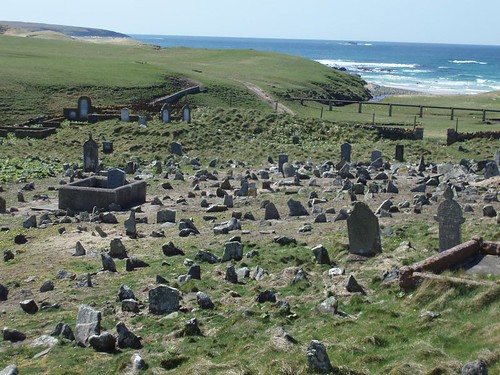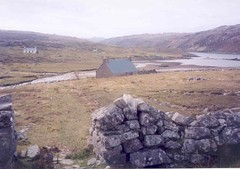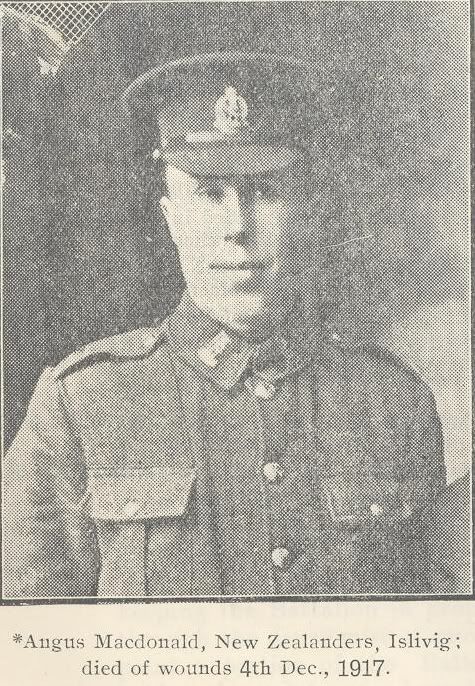his year, it will be 80 years ago since the islanders of St Kilda (Hiort) were evacuated to the Scottish mainland at their own request. It was on 29th August 1930 that the culture of St Kilda died with the passing to other shores of its inhabitants. This evening, Monty Halls in his Hebridean Hideaway visited the islands. The scenery was absolutely stunning. But otherwise, there was nothing there. There are no permanent residents left, the houses are ruinous, with a few exceptions, and the storage huts (cleits) stand empty and derelict. In other words, St Kilda is dead.
Monty Halls, who stayed in North Uist for six months from July 2009 onwards, got involved with the controversy surrounding the location of the St Kilda Centre. It will be a point where the culture and people of St Kilda will be celebrated and kept alive. The strife was bitter, and already reflected in Monty's programme. The other contestants were Mangersta (Lewis) and Leverburgh (Harris). Cleitraval (North Uist) is a hilltop location near Sollas, where a plaque sits on the hill, pointing out where St Kilda can be seen, 41 miles (70 km) away to the west.
In the end, the St Kilda Centre was allocated to Lewis, and will be erected off the road between Mangersta and Islivig, overlooking the cliffs of Mangersta to be reminiscent of the St Kilda clifftops. (This link will take you to the location courtesy Google Streetview). The people of Harris and North Uist are deeply upset over losing out over the centre. It will obviously bring tourists to the location involved, and Uig (in which Mangersta lies) can very well do with the revenue.
Some people in these islands have voiced misgivings over having a St Kilda Centre in the first place. I can have some sympathy with those who say it is not right to make money off people who were cruelly neglected by the Government of the day - and neglected they were. Conversely though, nothing will bring them back, and it is a way of keeping their memory and the memory of their culture alive.
Thursday, 22 April 2010
To be remembered
Norman Morrison, formerly of 10A South Dell in Lewis, died on 16 March 1917 after suffering with TB for 9 months. He had served on the Western Front, but was repatriated with gunshot wounds. He was interred at Swainbost Cemetery, but his grave was not marked. Norman would have qualified for a Commonwealth War Graves Commission (CWGC) gravestone, but was overlooked.
I have gathered what I hope is sufficient evidence for Norman to be included on the CWGC files and be afforded a proper gravestone. Even if his actual grave cannot be located.
I have gathered what I hope is sufficient evidence for Norman to be included on the CWGC files and be afforded a proper gravestone. Even if his actual grave cannot be located.
Thursday, 15 April 2010
Not remembered - 3
You may remember from a few weeks ago that I am working to get a casualty of the First World War on the Commonwealth Wargraves Commission register. Things have progressed, and the last piece of the jigsaw is about to fall into place. In the next day or so, I shall receive confirmation that Norman Morrison, formerly of 10A South Dell, was buried at the Swainbost Cemetery on 16 March 1917. He died 9 months after contracting turberculosis.
Once I have confirmation, a case will be submitted to the CWGC to have Norman entered onto their records. A CWGC wargrave stone will then be erected at the cemetery.
In connection with this, it has come to my attention that reservists who died after being discharged from war service do not qualify for CWGC status. Not fair, is it?

This is the Swainbost Cemetery, where 9,000 people have been buried since the 16th century.Norman Morrison's grave is somewhere in here - each stone represents a grave.
Once I have confirmation, a case will be submitted to the CWGC to have Norman entered onto their records. A CWGC wargrave stone will then be erected at the cemetery.
In connection with this, it has come to my attention that reservists who died after being discharged from war service do not qualify for CWGC status. Not fair, is it?

This is the Swainbost Cemetery, where 9,000 people have been buried since the 16th century.Norman Morrison's grave is somewhere in here - each stone represents a grave.
Saturday, 10 April 2010
Crola and Islivig
 Two interesting findings in the course of my local history research (see map above, click on markers to see locations). First was an interesting census record of the village of Crola. This is no longer inhabited. It stands at Kinlochresort, the head of Loch Resort, in the remote west of Lewis. In 1891, a shepherd's family resided there. Catherine Macdonald, aged 63, is quoted as a shepherd's widow, living there with her two fishermen sons John (41), Malcolm (26) and daughter Annie (22). There is also a granddaughter Ann, aged 13, presumably (but not certain) the child of John. Catherine's home is marked as having two rooms with windows. The noteworthy thing is that her offspring is marked as living in Lewis, whereas she and her granddaughter Ann, aged 13, are marked as being born in Harris. This is significant, because Lewis used to be part of Ross and Cromarty, and Harris was part of Inverness-shire.The confusion arises on account of the fact that the county boundary ran at Kinlochresort. On the Harris side of the river lies Luachair, also uninhabited today (white house in image to the right). Would you believe that there was once a school at Crola, which was a so-called side school to the main village school at Loch Croistean, a mere ten miles away. More stories on the local historical society website.
Two interesting findings in the course of my local history research (see map above, click on markers to see locations). First was an interesting census record of the village of Crola. This is no longer inhabited. It stands at Kinlochresort, the head of Loch Resort, in the remote west of Lewis. In 1891, a shepherd's family resided there. Catherine Macdonald, aged 63, is quoted as a shepherd's widow, living there with her two fishermen sons John (41), Malcolm (26) and daughter Annie (22). There is also a granddaughter Ann, aged 13, presumably (but not certain) the child of John. Catherine's home is marked as having two rooms with windows. The noteworthy thing is that her offspring is marked as living in Lewis, whereas she and her granddaughter Ann, aged 13, are marked as being born in Harris. This is significant, because Lewis used to be part of Ross and Cromarty, and Harris was part of Inverness-shire.The confusion arises on account of the fact that the county boundary ran at Kinlochresort. On the Harris side of the river lies Luachair, also uninhabited today (white house in image to the right). Would you believe that there was once a school at Crola, which was a so-called side school to the main village school at Loch Croistean, a mere ten miles away. More stories on the local historical society website.One of the nearly 1300 local casualties was Angus Macdonald, who served with New Zealand forces in France. He died of wounds on the Western Front on 4 December 1917. A naturalised American national, Angus must have crossed the Pacific after emigrating to the States. He was born in the hamlet of Islivig in the district of Uig, 40 miles west of Stornoway.
Labels:
"new zealanders",
islivig,
kinlochresort,
uig,
ww1
Tuesday, 6 April 2010
Isle of Rum
I am very pleased to be able to report that Scottish Natural Heritage, who own and manage the nature reserve of the Isle of Rum in the Inner Hebrides, has signed over assets worth £257,000 to the island's community association. Rum has a checkered history, and it is a good thing that the island's residents, after 190 years, get control of their homes and village.
Rum's indigenous Hebrideans were expelled from the island in 1821, to make way for sheep, later deer. In the late 19th century, the island was bought by a Lancashire family of industrialists, the Bulloughs, who made their fortune in the textile industries. They built a folly-type castle at Kinloch, filled with the most mind-boggling and jaw-dropping artefacts. Some amongst the ugliest pieces I've ever clapped eyes on. After the First World War, the castle began to fall into disuse, and the last member of the Bullough family passed away in 1957. Lady Monica was carried the hard eight miles to Harris, on the island's southwest coast, to be interred in the family mausoleum.
Rum was bequeathed to the nation, and (what is now) SNH took over. The island became a nature reserve, with a colony of red deer being studied. Its only residents were SNH staff. The present take-over clears the way to increase the island's population from 30 to 80.
Rum's indigenous Hebrideans were expelled from the island in 1821, to make way for sheep, later deer. In the late 19th century, the island was bought by a Lancashire family of industrialists, the Bulloughs, who made their fortune in the textile industries. They built a folly-type castle at Kinloch, filled with the most mind-boggling and jaw-dropping artefacts. Some amongst the ugliest pieces I've ever clapped eyes on. After the First World War, the castle began to fall into disuse, and the last member of the Bullough family passed away in 1957. Lady Monica was carried the hard eight miles to Harris, on the island's southwest coast, to be interred in the family mausoleum.
Rum was bequeathed to the nation, and (what is now) SNH took over. The island became a nature reserve, with a colony of red deer being studied. Its only residents were SNH staff. The present take-over clears the way to increase the island's population from 30 to 80.
Subscribe to:
Comments (Atom)


